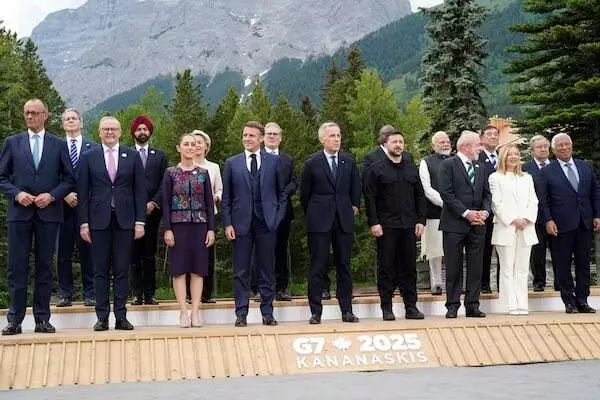G7 on the Edge: Can the World's Old Guard Reinvent Itself in a New World Order!

As the Group of Seven (G7) convenes in the remote Canadian mountain town of Kananaskis for its 50th annual summit, it does so at a moment of heightened global uncertainty. The leaders of Canada, France, Germany, Italy, Japan, the United Kingdom, and the United States—long considered the architects of the post-war liberal order—are now confronted with a dramatically shifting geopolitical and economic landscape. Against the backdrop of rising global tensions and eroding multilateral cohesion, the G7 finds itself under immense pressure to prove its continuing relevance.
Two pressing issues dominate the 2025 agenda: the rekindled conflict between Iran and Israel, which threatens to further destabilize an already fragile Middle East, and the looming specter of U.S. tariffs under the administration of former President Donald Trump. His return to political prominence—and the unpredictability that comes with it—has cast a long shadow over the summit, forcing world leaders to re-examine the unity and purpose of the G7.
Trump’s history with the G7 is well-remembered for its disruption. In 2018, he famously refused to sign the final communiqué, accusing then-Canadian Prime Minister Justin Trudeau of making "false statements" and derailing what was meant to be a show of unity. His confrontational stance on global trade, preference for bilateral deals over multilateral ones, and aggressive tariff policies undermined the G7’s traditional role as a driver of collective economic strategy. Now, with Trump once again shaping U.S. trade policy, G7 leaders are left guessing how to maintain cohesion while anticipating dramatic policy swings.
That concern is not limited to the original member states. For this summit, leaders from emerging economies—including India, Brazil, Mexico, South Korea, Australia, and Ukraine—have been invited to the table. Their presence reflects a growing realization among G7 nations: the global center of gravity is shifting, and the group can no longer afford to operate in a vacuum. These rising powers are not only economic heavyweights but increasingly influential voices in shaping global norms on technology, climate, and security.
Once commanding over 60% of global GDP, the G7’s collective share has declined to approximately 44%—a symbolic indicator of the rise of Asian economies, especially China and India. This economic rebalancing calls into question the G7’s ability to dictate the rules of global trade and finance as it once did. The bloc now stands at an inflection point, caught between the legacy of Western dominance and the necessity of broader inclusion.
Japan remains the only Asian member of the G7, highlighting the group’s continued Western orientation despite the pronounced eastward shift in global power. This lack of geographic and economic diversity is increasingly seen as a handicap. Emerging economies view the G7 as a somewhat outdated institution—one that must evolve if it hopes to remain relevant in shaping international policy. These countries expect more than token invitations; they seek meaningful dialogue and shared decision-making authority in global governance structures.
Internal fragmentation further complicates the G7’s prospects. Diverging national interests have made consensus difficult on crucial issues like climate change, digital regulation, and geopolitical strategy. While all members profess a commitment to democratic values and multilateral cooperation, disagreements on how to implement these principles have resulted in inconsistent messaging and diluted impact.
The rise of bilateralism is perhaps the clearest symptom of this decline in collective action. Faced with Trump’s unpredictable trade tactics, G7 nations have increasingly opted to strike individual deals with the United States rather than confront trade disputes as a united front. While tactically expedient, this approach weakens the bloc’s strategic coherence and undermines its value as a collective bargaining force. In doing so, the G7 risks becoming more of a symbolic forum than a decisive policy-making institution.
Yet the G7’s diminished influence is not a foregone conclusion. Its future now hinges on its ability to reinvent itself to meet the demands of a rapidly changing world. This means moving away from exclusivity and toward a more inclusive, cooperative model that recognizes the agency and aspirations of non-Western states. Building genuine partnerships—particularly with India and China—is essential if the G7 hopes to continue playing a central role in global affairs.
It also requires a reaffirmation of core multilateral principles among its own members. Without a strong foundation of trust and shared vision, the bloc cannot hope to lead on major issues like climate change, cyber security, or economic inequality. The ability to act decisively in moments of global crisis depends not only on hard power or GDP figures, but on credibility, unity, and a willingness to listen beyond traditional power circles.
This summit is a litmus test. Will the G7 remain a relic of a bygone era, or will it evolve into a nimble, inclusive coalition capable of navigating today’s complex multipolar world? The answer depends on whether its leaders can look beyond short-term political calculations and toward a reimagined global role—one rooted in cooperation, not competition; shared responsibility, not unilateral assertion.
In many ways, the Kananaskis Summit is less a celebration of 50 years than a reckoning with them. The G7 must decide: adapt or risk irrelevance. The stakes could not be higher.
